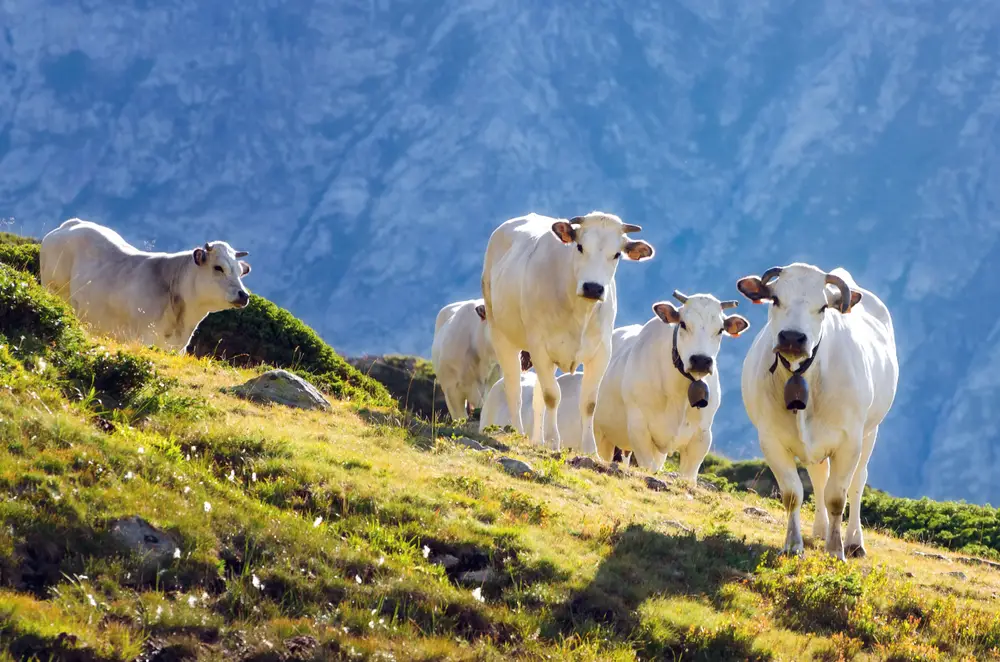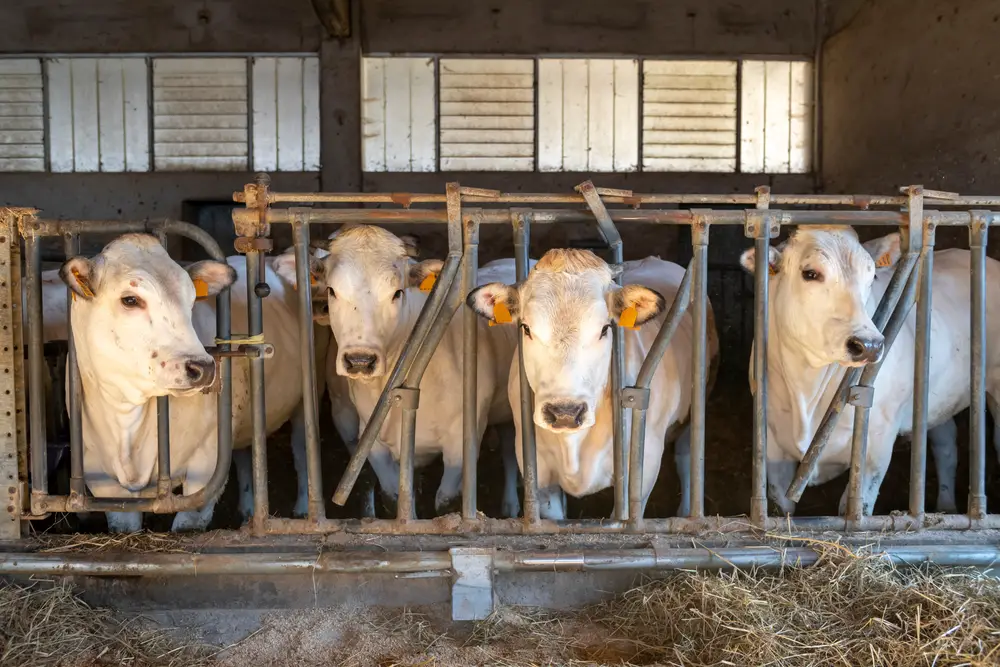Also called razza bovina Piemontese, Piedmontese cattle are an interesting breed because of their double-muscling trait that stems from a gene mutation.
This article explores the peculiarities of the Piedmontese breed along with its origin, history, characteristics, uses, and health issues.
Let’s explore together!
Table of Contents
Piedmontese Cattle History and World Distribution
The origin of Piedmontese cattle is traced to the Piedmont region in northwest Italy, a secluded region bordered by the Alps.
Piedmontese cattle are a mix of two breeds of cattle—the Auroch (Bos Primigenius) and Pakistani Zebu. The Aurochs were among ancient European cattle breeds of the Bos Taurus species that inhabited the Piedmont region.

A massive migration of Zebu cattle (Brahman cattle) from Pakistan brought the Pakistani Zebus to the Piedmont valleys, where the Alps mountain range curtailed their migration.
The Zebus and Aurochs bred and evolved over thousands of years into the Piedmontese breed, famous for postpartum muscular hypertrophy or the double muscle factor.
In 1886, cattle breeders were drawn into the Piedmontese breed because of the appearance of the double muscle factor.
The first Piedmontese Italian herdbook was started in 1887, marking the installation of breeding programs for improving the cattle and eradicating the complications that came with double-muscling.
As was discovered more than a century later, the double-muscling in Piedmontese cattle is caused by a mutation of the myostatin gene that is naturally present in all mammals.
When it is active, the myostatin gene regulates muscle growth and development by telling the animal’s muscles to stop growing.
An inactive myostatin gene is caused by a mutation, and it leads to the double-muscling witnessed in the Piedmontese breed.
Now, it’s important to clear the air here: double-muscling doesn’t describe a condition where a mammal forms twice the muscle but rather a condition that causes the formation of increased muscle fiber.
The inactive myostatin gene causes an increase in red meat yield in Piedmontese cattle. It also leads to the unique tenderness of Piedmontese beef.
The heavy musculature or bulk muscle mass means Piedmontese have much more meat than most other breeds of cattle.
Purebred or full-blood Piedmontese bulls and cows are homozygous, meaning their inactive myostatin gene manifests in two identical alleles.
Beside increasing red meat yield and causing unique tenderness, double-muscling in full-blood Piedmontese also means that the beef has less marbling, a higher lean-to-fat ratio, and less connective tissue.
Purebred Piedmontese beef is also fast-cooking compared to meat from Piedmontese cross breeds and other cattle breeds like Wagyu, whose beef is famed for its high marbling.
Piedmontese in North America
The Piedmontese breed came to North America from Italy by importing bulls and cows in the late 1970s into Canada and in the early 1980s into the US.
North American Piedmontese cattle began when the importation of the breed became possible in Canada in 1979 by the Piedmontese Breeding Co-operative and in the early 1980s in the US.
Back then, there weren’t as many Piedmontese cattle in the world. The estimated population of the cattle in Italy was 230,000 registered head and 70,000 unregistered head.
The Anaborapi—National Association of Piedmontese Cattle Breeders, headquartered in Carrù, Piemonte, is responsible for the development and genetic enhancement of the Piedmontese breed.
The association, established in 1960, maintains a herdbook for Piedmontese cattle and is responsible for running a Genetic Station and an Artificial Insemination Station.
The Genetic Station handles progeny tests and performance tests, while the AI Station oversees the production of semen from selected Piedmontese bulls.
The semen and embryos find their way to other parts of the world, giving ranchers and family cattle farmers a chance to raise their own Piedmontese cattle.
Today, Piedmontese cattle are found in Canada, the US, Great Britain, New Zealand, Mexico, Australia, Holland, Denmark, and Poland.
Piedmontese Cattle Characteristics
Piedmontese cattle have the following set of characteristics:
- White to light grey color with black pigmentation in the hooves, muzzle, tail switch, horns, ears, distal leg region, and around the eyes.
- Calves are born with a pale fawn color and turn grey-white as they mature
- High fertility
- Longevity
- Postpartum muscular hypertrophy
- Light bone structure
- Long slim calves
- Excellent mothering ability
- Low-fat, low-cholesterol beef
- Adaptability to different climates
- Docility
- Both cows and bulls are horned (small horns)
- High feed conversion efficiency
- 1,200-1,400 pounds in average weight for cows and 1,500-1,900 average weight for bulls.
- 90 pounds average live weight at birth.
Piedmontese Cattle Personality
Piedmontese cattle have excellent mothering ability and are docile. The calm dams have an inherent compulsion to protect their offspring, so you’ll not want to do anything that makes the mothers see you as a threat to their babies.
For their large size and calmness, you can think of the Piedmontese cattle as gentle giants that aren’t prone to aggression brought about by learning, hormonal changes, or fear.
What Are Piedmontese Cattle Used For?
From their early days in Piedmont in northwest Italy, the Piedmontese cattle were a triple-purpose breed that provided milk, beef, and draught power.
Over the years, the cattle have transitioned into a dual-purpose breed for beef and milk production. The milk from Piedmontese cows is used to make traditional Italian cheeses such as Toma Piemontese, Castelmagno, Raschera, and Bra.

Piedmontese beef is marketed as premium quality meat because of its excellent tenderness and leanness compared to meat from other beef cattle.
The tenderness is because the muscle fibers of the cattle are uniquely tender, while the leanness is because the beef has less fat content than other cattle breeds.
The Piedmontese have the lowest fat thickness compared to other cattle like Angus and Hereford.
Since the Piedmontese breed is still uncommon in many places, active breeding for full-bloods and Naturaleans is still ongoing.
The North American Piedmontese Cattle Association (NAPA) notes that there has been continued importation of Piedmontese cattle semen and embryos (genetic material), which has increased the wealth of bloodlines ranchers and farmers can choose from.
Drawbacks of Piedmontese Cattle
While Piedmontese cows and bulls are widely celebrated for their premium quality beef, they are not without drawbacks. One significant Piedmontese cattle drawback is that they usually have calving complications.
But don’t get this wrong—Piedmontese cows generally have easy calving because the calves are usually long and slim, and the muscular hypertrophy condition is postpartum (calves start double-muscling a few weeks after birth.)
However, some Piedmontese cows may have difficulties calving down if they are overfed with protein in the third trimester of their pregnancy.
Giving your cows too much protein from plants like alfalfa causes them to bear large calves, which causes birth complications because the mother won’t be able to pass them freely.
The relief comes from advancements in breeding, which make it possible to reduce the instances or risks of overly large Piedmontese calves at birth. However, limiting protein intake in the last trimester is still advisable.
